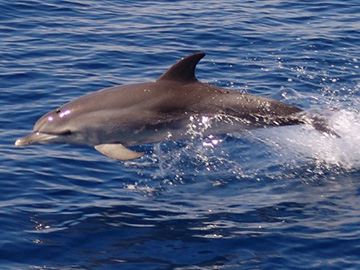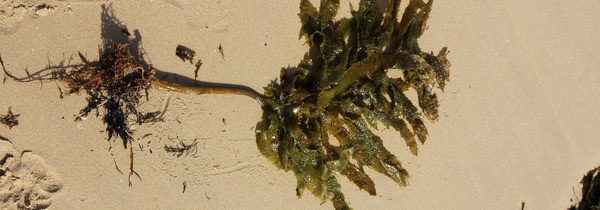Tom Parkinson's monthly column, introducing the diverse range of flora and fauna on show at Sanctuary Lakes.
A couple of weeks back on a bright sunny still winter's morning, I took a walk along our nearest beach, the Point Cooke Marine Sanctuary's shoreline. This local treasure and our next-door neighbour, is the largest Marine Park in Victoria and protects an astounding array of native sea life. The best access to the beach is to drive to the old Point Cook homestead car park and then walk the fifty metres over the soft dunes to the narrow sandy beach. Standing on the water edge you are immediately relaxed by the soft rhythmic and caressing sounds of sea shore and the warmth of winter's sun reflecting from the sea's surface.

One of the joys of living in Sanctuary Lakes and wandering around the neighbourhood is the way nature can suddenly and unexpectedly surprise. Again, it happened!
 Bottlenose Dolphin (Tursiops Australis) A Squeaky whistle, a splash, another whistle, a clicking sound and another splash and there they were, less than 100 metres from the shoreline, a pod of six to eight Bottlenose Dolphins enjoying the fun of noisily catching an early fresh fish lunch.
Bottlenose Dolphin (Tursiops Australis) A Squeaky whistle, a splash, another whistle, a clicking sound and another splash and there they were, less than 100 metres from the shoreline, a pod of six to eight Bottlenose Dolphins enjoying the fun of noisily catching an early fresh fish lunch.
Port Phillip Bay supports at least three to four small Bottlenose Dolphin pods and thanks to the abundance of their favourite fishy foods they are regular visitors to our Marine Sanctuary. The common Bottlenose Dolphin is grey in colour with an off-white belly and the adults may be between 2 and 4 metres long. They have a short-rounded snout, described as bottle-shaped, with a smooth rounded melon face. The large dorsal fin is slightly hooked and set half way along the body. They are sleek and streamlined allowing them to swim at speeds of up to 35km per hour.
The Bottlenose Dolphins are a very social species and often feed together. They use echo-location to find prey and to develop a picture of their surroundings. By making clicking sounds and waiting for the echo to return from surrounding objects, they can determine how far away the object is and how big it might be. Working together as a group, dolphins can trap schools of fishes or squids by rounding them up and diving into the middle to feed. They also use their whistle and clicking sounds to communicate with one another over considerable distances.
Bottlenose Dolphin calves are born in the water after a gestation period of one year and suckle for about 18 months. They will remain with the mother for about four years. They are a long-lived species, with an extensive life span of up to 45 years.
Pods of feeding Dolphins are always a joy to watch, but they disappear almost as quickly as they suddenly arrive. One moment whistling, clicking, diving, next calm water and thirty seconds later, some 250 metres away, the jump for breath.
It's not unusual to see Dolphins from our shoreline, but to see them close up is relatively rare. On my years of rambling our marine sanctuary it has only happened twice before.
As the Dolphins disappeared further to the horizon I turned north and walked along the beach to the Skeleton Creek mouth. Point Cooke Marine Sanctuary’s main plant growth is the common kelp, Ecklonia Radiata or Brown Algae. Its dry detritus can be seen all along the beach marking the parameters of the high tide.

This 2m long brown seaweed appears as brownish yellow and green. The 'leaves' are small spikes with a crinkled, grooved appearance and saw-toothed edge. It is one of the vital ecological life bloods of the marine sanctuary. Its rich nutriments are a key food for numerous small and large invertebrates, fish, crabs, jellyfish, squid and even pecked over by wading shore birds. And a tip for the Gardening fans, Brown Algae is an excellent compost to boost your soil nutrients.
I reached Skeleton Creek's shallow descent into the Bay and looked across to St Kilda, about 300 metres out from the shore a patch of placid water started to create a small turbulence. The dolphins must be returning, but no, nature again held a surprise and bursting through the water came a Humpback Whale joyfully breaching. This was my third viewing in as many weeks of Humpbacks around our Marine Sanctuary. Once was on the Port Arlington, Werribee, Docklands ferry where the captain kindly steered the ferry to within 50 metres of two humpbacks allowing both humans and whales to closely and curiously inspect one another.
According to an East Coast whale counting group, Australia's humpback population is the healthiest it has been since whaling ended along the east coast in the 1960s. They have counted between 28,000 and 30,000 whales this migration season, the highest seen in decades.
 Humpback Whale megaptera novaengliae Humpbacks as the name suggests are not slender and graceful in fact they are quite stout and stocky and easily recognised by their long distinctive pectoral fins (their 'arms') and obvious hump. Adults will grow up to 15-16 metres.
Humpback Whale megaptera novaengliae Humpbacks as the name suggests are not slender and graceful in fact they are quite stout and stocky and easily recognised by their long distinctive pectoral fins (their 'arms') and obvious hump. Adults will grow up to 15-16 metres.
Their annual migration between Australia and the Antarctic is the longest of any mammal, feeding in Antarctic waters on krill but eating small fish and plankton during their migration to and from their breeding areas. Humpbacks will typically breed every two or three years. The gestation period is 11.5 months. The peak months for birth are July and August. Females wait for one-to-two years before breeding again.
Humpbacks communicate among themselves with their now famous songs. Normally less than 10 minutes, but rotated for up to an hour. It has recently been noticed that Humpback will change and learn new songs on an almost annual basis. They also make other sounds to communicate, such as grunts, groans, snorts and barks.
It says a lot for our neighbourhood that we have our own International Bird Sanctuary next to the Point Cooke Marine Park containing all this wonderful marine wildlife that is happening less than 3km, as the crow flies, from the club house. This coming summer I will be putting on my snorkel and cataloguing the amazing action underwater of our marine sanctuary.